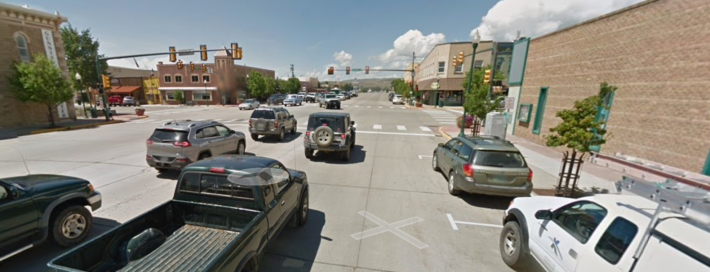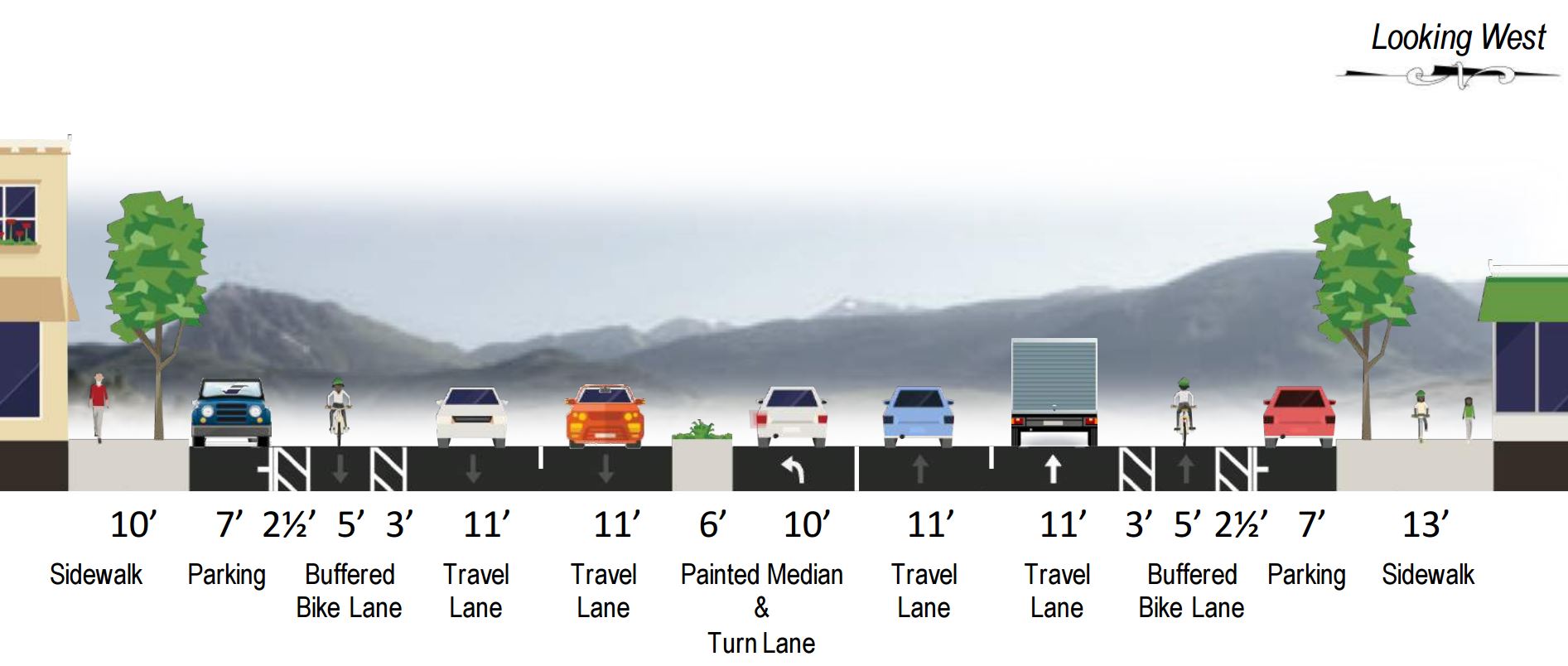Gunnison: Base Camp of the Rockies gears up for bike lanes
The City of Gunnison emits a siren call for folks who love the Colorado lifestyle. Look up “Things to do in Gunnison” on Trip Advisor and you’ll find that nine of the top ten are outdoor sports activities. Despite this, it’s a town that can be difficult to navigate by bike or on foot.
A unfortunate truth: Main Streets aren’t always people-friendly.
Two highways bisect the community. That’s not unique to Gunnison, and historically it made sense. But as 21st century transportation priorities shift from moving vehicles quickly to moving people safely, Main Street highways are problematic. Heavy trucks, highway speeds and non-local traffic create significant challenges for bicyclists and pedestrians.

 Both Tomichi Avenue (SH-50) and Main Street (CO-135) are exceptionally wide, acting more as barriers than connectors. Wide streets encourage speeding, which makes Tomichi Avenue and Main Street dangerous to cross. Residents and tourists alike must traverse five to six lanes of traffic with minimal traffic controls. This includes kids walking and biking to school.
Both Tomichi Avenue (SH-50) and Main Street (CO-135) are exceptionally wide, acting more as barriers than connectors. Wide streets encourage speeding, which makes Tomichi Avenue and Main Street dangerous to cross. Residents and tourists alike must traverse five to six lanes of traffic with minimal traffic controls. This includes kids walking and biking to school.
Alarmed by the dangerous conditions, community group “Citizens for Safe Streets” and the Gunnison City Council began working together to improve safe travel for pedestrians and bicyclists in Gunnison through petitions and messaging campaigns.
Council member Leia Morrison, who also owns The Sanctuary Yoga Studio on Main Street and is a mom, has been a dedicated advocate for improving both roads. “This is an opportunity to brand Gunnison for what it is: the Base Camp of the Rocky Mountains. We have the chance to proactively shape and influence people’s perceptions of our town, not only in terms of visitors but also to influence the minds of potential residents who are looking to relocate, start up a business or retire.”
A frustrating truth: Complete streets projects are exciting…and complicated.
In 2015, the city hired Fox Tuttle Hernandez Transportation Group (FTH) to work with residents, business owners, elected leaders, city staff and the Colorado Department of Transportation (CDOT) to redesign Tomichi Avenue and Main Street. Interactive community workshops identified potential design solutions that fit the character of Gunnison.
In April 2016, FTH presented the design recommendations informed by two community workshops and inspired by leading-edge national best practices. The design included parking-buffered bike lanes, traffic calming, pedestrian refuges and a CDOT-approved, fully protected intersection that, if built, would be a first in Colorado. It was everything the working coalition hoped for, and it created quite a bit of buzz.
[fusion_builder_container hundred_percent=”yes” overflow=”visible”][fusion_builder_row][fusion_builder_column type=”1_1″ background_position=”left top” background_color=”” border_size=”” border_color=”” border_style=”solid” spacing=”yes” background_image=”” background_repeat=”no-repeat” padding=”” margin_top=”0px” margin_bottom=”0px” class=”” id=”” animation_type=”” animation_speed=”0.3″ animation_direction=”left” hide_on_mobile=”no” center_content=”no” min_height=”none”]
An exciting truth: Complete streets usually solve multiple problems.
The proposed corridor design also activated new stakeholders concerned about impacts on local businesses and the $4.5M cost. “Everyone loves a bike lane until it’s in front of their business or home and until they have to pay for it” is a common expression for transportation planners.
[/fusion_builder_column][fusion_builder_column type=”1_1″ background_position=”left top” background_color=”” border_size=”” border_color=”” border_style=”solid” spacing=”yes” background_image=”” background_repeat=”no-repeat” padding=”” margin_top=”0px” margin_bottom=”0px” class=”” id=”” animation_type=”” animation_speed=”0.3″ animation_direction=”left” hide_on_mobile=”no” center_content=”no” min_height=”none”]
A third community workshop was held in May and included more business owners, addressed concerns and misinformation and informed a final corridor plan with affordable quick wins, including buffered bike lanes, which improve safety and retain on-street parking. And, as community stakeholders worked together to improve safety, the design quickly incorporated arts, placemaking and economic development. The city plans to move forward with the bike lanes in 2017 while also pursuing funding for the bigger “Base Camp of the Rockies” vision.
 [/fusion_builder_column][/fusion_builder_row][/fusion_builder_container]
[/fusion_builder_column][/fusion_builder_row][/fusion_builder_container]
Leave A COMMENT
Our twitter feed is unavailable right now.








